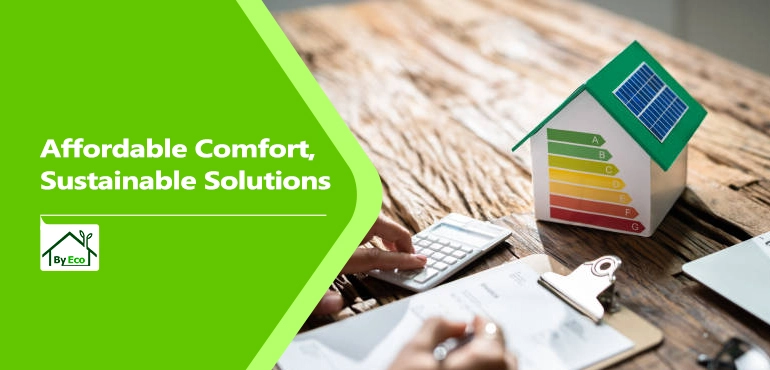The Most Cost-Effective Insulation Solutions in the UK

When seeking the cheapest insulation in the UK, homeowners often consider various factors to balance cost-effectiveness with quality. From insulation materials to affordable insulation for walls, finding the cheapest insulation can be a crucial decision in home improvement projects. Exploring the cheapest insulation available ensures not only affordability but also effectiveness in maintaining energy efficiency and comfort within your home.
Discovering the most cost-effective insulation solutions aligns with ByEco's commitment to making sustainable living accessible to all.
Affordable Insulation Solutions in the UK
When it comes to enhancing energy efficiency and comfort in your home, finding the right insulation solution is crucial. Fortunately, in the UK, there's a wide range of cost-effective options available to answer various needs and budgets. From cheaper insulation boards to affordable insulation materials, homeowners have plenty of choices to explore.
Commonly Used Insulation Materials
1. Fibreglass Insulation:
Fibreglass insulation is a popular choice for its cost-effectiveness and versatility. Made from fine glass fibres, it is available in batts, rolls, or loose-fill forms. Fibreglass insulation effectively reduces heat transfer and enhances energy efficiency, making it a practical option for homeowners on a budget.
2. Cellulose Insulation:
Cellulose insulation is another budget-friendly option made from recycled paper treated with fire-retardant chemicals. It offers good thermal insulation and soundproofing properties, making it suitable for various applications in walls and attics.
3. Spray Foam Insulation:
While spray foam insulation may have higher upfront costs, it offers long-term savings and benefits. It provides superior thermal performance and creates an airtight seal, minimising air leakage and maximising energy efficiency in walls and roofs.
4. Mineral Wool Insulation:
Mineral wool insulation is made from natural minerals like basalt or rock and offers excellent fire resistance and thermal insulation properties. It is available in batts, rolls, or loose-fill forms, making it suitable for various wall cavities and attics.
5. Polystyrene Insulation:
Polystyrene insulation comes in two main forms: expanded polystyrene (EPS) and extruded polystyrene (XPS). EPS insulation is lightweight and cost-effective, while XPS insulation has a denser composition, making it ideal for below-grade and damp environments.
The R-Values of Commonly Used Insulation Materials
When exploring insulation options, understanding the concept of R-value (thermal resistance) is essential. The R-value measures the ability of a material to resist heat flow. The higher the R-value, the better the insulation's effectiveness in preventing heat transfer. Here's a breakdown of the R-values for commonly used insulation materials:
| Insulation Material | R-Value per Inch |
|---|---|
| Fibreglass Insulation | 2.2 - 2.7 |
| Cellulose Insulation | 3.2 - 3.8 |
| Spray Foam Insulation | 3.5 - 6.5 |
| Mineral Wool Insulation | 3.0 - 3.3 |
| Polystyrene Insulation (EPS) | 3.6 - 4.0 |
| Polystyrene Insulation (XPS) | 4.5 - 5.0 |
Comparing Costs: Which Insulation Option Offers the Best Value?
When comparing costs and determining the best value for insulation options, it's essential to consider various factors and insulation types.
Cavity wall insulation proves ideal for homes with cavity walls, utilising insulating materials such as mineral wool or polystyrene beads to minimise heat loss. This method typically ranges from £1,500 to £5,000.
Solid wall insulation presents two options: internal and external. Internal solid wall insulation, suitable for homes lacking cavity walls, involves adding a layer internally, with costs typically falling between £10,000 and £15,000. Conversely, external solid wall insulation, also for homes without cavity walls, adds a layer externally, with prices ranging from £12,000 to £18,000.
Loft insulation emerges as a crucial method for preventing heat loss and maintaining warmth within homes, with prices typically ranging from £1,500 to £2,500.
Underfloor insulation targets heat loss through floors, particularly beneficial for homes with suspended timber floors, with costs ranging from £5,000 to £8,000.
For park homes, especially those constructed before 2005, comprehensive insulation covering underfloor, external wall, and loft areas is available, typically costing between £6,000 and £10,000.
Solid floor insulation is crucial for homes with solid ground floors, as it involves adding materials beneath the floor to reduce heat loss. Costs for this type of insulation typically range from £8,000 to £12,000.
Lastly, roof insulation offers tailored solutions for various roof types, minimising heat escape and enhancing comfort and energy efficiency. Prices vary based on roof type and insulation method, typically ranging from £4,000 to £6,000.
The price estimates provided are based on average expenses for medium (3-4 bedrooms) semi-detached houses, which are a common type of housing in the UK.
These estimates offer valuable insights for homeowners seeking to determine the most cost-effective insulation solution tailored to their specific needs. By considering factors such as insulation type, home size, and construction materials, individuals can make well-informed decisions that align with their budget and energy efficiency goals. Understanding these cost estimates within the context of one's own property can guide homeowners in selecting the insulation option that offers the best long-term value. Whether it's cavity wall insulation, loft insulation, or solid floor insulation, evaluating these estimates ensures homeowners maximise their investment in energy efficiency improvements.
Factors Influencing the Cost of Insulation Installation
Discovering the cheapest insulation options is essential for homeowners seeking to enhance energy efficiency while managing costs. Understanding the key factors influencing installation costs is crucial before starting any insulation project. From property size to installation complexity, each aspect impacts the overall expenses. Below, we explore these factors in detail, providing insights to help homeowners make informed decisions.
Property Size:
The size of your property directly impacts the amount of insulation materials needed, influencing overall costs. Larger homes necessitate more insulation materials, resulting in higher expenses due to the increased surface area to cover. Understanding your property's dimensions and square footage is essential for accurately estimating the quantity of insulation required to achieve optimal energy efficiency and comfort.
Insulation Methods:
Various insulation methods contribute to cost variations, influenced by factors such as material type, installation complexity, and equipment requirements. Each insulation method offers distinct advantages and cost implications, making it crucial to select the most suitable option based on your budget and performance expectations. By comparing the cost-effectiveness of different insulation methods, homeowners can make informed decisions to maximise their investment in energy efficiency improvements.
Installation Complexity:
Standard Installations:
Standard installations involve straightforward processes with easy access to the installation area. This typically applies to properties with simple layouts and no significant obstacles or challenges. Standard installations are characterised by efficient workflows and minimal disruptions, resulting in cost-effective insulation solutions for homeowners.
Challenging Installations:
Challenging installations present unique obstacles and complexities that require additional time and effort to complete. This may include properties with complex layouts, inaccessible areas, or architectural features that pose challenges to the installation process. Factors such as limited access to the installation area, obstructions like pipework or electrical fixtures, and irregular wall surfaces contribute to the complexity of the installation. As a result, challenging installations often incur higher labour costs due to the specialised expertise and resources required to overcome these obstacles and ensure effective insulation coverage.
Energy Efficiency: Maximising Savings with the Right Insulation Choice
Examining the expected savings of different insulation types alongside their initial expenses provides valuable insights to guide your decisions. This approach ensures alignment with both your financial considerations and long-term sustainability objectives. Below is a breakdown providing information about saving expectations for each type of home insulation.
Cavity Wall Insulation: Expected savings range from £200 to £250 annually. Cavity wall insulation offers significant energy savings by reducing heat loss through the walls, resulting in lower heating bills and increased comfort levels throughout the year.
Solid Wall Insulation: Anticipated savings vary between £250 and £400 per year. Solid wall insulation provides substantial thermal performance improvements, leading to enhanced energy efficiency and reduced heating costs, particularly in homes with solid walls.
Loft Insulation: Expected savings range from £150 to £220 annually. Loft insulation helps prevent heat loss through the roof, resulting in lower energy consumption for heating and cooling purposes and a more consistent indoor temperature.
Flat/Pitched Roof Insulation: Anticipated savings fall between £200 and £300 per year. Roof insulation contributes to maintaining a comfortable indoor environment by minimising heat transfer through the roof structure, leading to decreased energy usage and reduced utility bills.
Underfloor Insulation: Expected savings range from £100 to £150 annually. Underfloor insulation helps minimise heat loss through the floor, resulting in improved thermal comfort and energy efficiency, particularly in homes with suspended timber floors.
Park Home Insulation: Anticipated savings vary between £300 and £500 per year. Park home insulation offers significant energy savings by enhancing thermal performance and reducing heat loss, resulting in lower heating costs and increased comfort for occupants.
Solid Floor Insulation: Expected savings fall between £150 and £250 annually. Solid floor insulation helps minimise heat loss through the ground floor, leading to improved energy efficiency and reduced heating bills, especially in homes with solid ground floors.
Room-in-Roof Insulation: Anticipated savings range from £200 to £350 per year. Room-in-roof insulation contributes to maintaining a consistent indoor temperature by reducing heat loss through the roof space, resulting in lower energy consumption and enhanced comfort levels.
Insulation Grants in the UK
If you're looking to save money on insulation for your home, government grants can be a great way to make upgrades more affordable. In the UK, programs like the Great British Insulation Scheme (GBIS) and the Energy Company Obligation (ECO4) offer grants to qualified homeowners for free or discounted insulation installations, which can help lower the costs of improving energy efficiency in your home.
The Great British Insulation Scheme (GBIS):
The Great British Insulation Scheme (GBIS), initiated in April 2023 and active until March 2026, aims to deliver cost-effective insulation measures to a broad range of households in the UK, thereby enhancing access to insulation and contributing to quicker, more effective energy efficiency improvements across the UK.
The Energy Company Obligation (ECO4):
Active until March 2026, The Energy Company Obligation (ECO4) targets the enhancement of insulation and heating systems in homes across the UK, with a focus on supporting low-income, fuel-poor, and vulnerable households. It facilitates the adoption of energy-saving measures, providing funding for upgrades like cavity wall, loft, and underfloor insulation. This scheme is instrumental in reducing energy bills and carbon emissions, making homes warmer, more comfortable, and environmentally friendly.
Discover Your Eligibility for Free Insulation
Find out if you qualify for free insulation services through ECO4 or GBIS by completing our form. Our partnership with the government ensures that eligible homes can receive necessary insulation upgrades at no cost or at a reduced cost.

Steps After Eligibility
- If you're a tenant: we coordinate with your landlord to ensure all contributions and permissions are in place.
- Home Assessment: Our assessors will visit to pinpoint the ideal energy solution for you.
- Scheduling Your Installation:We arrange installation at your convenience, using verified installers to do the job right.
